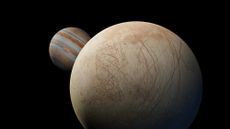A massive black hole may help scientists establish a better timeline for our universe


Scientists can now estimate when stars first began to light up the cosmic universe, thanks to the discovery of a supermassive black hole, NPR reports.
The black hole is 800 million times larger than our sun, nestled inside a bright object called a quasar, which is an emanating light that took 13 billion years to reach Earth. The black hole formed only 690 million years after the Big Bang — aka, when the universe was just 5 percent of its current age, NPR writes.
This behemoth black hole formed when stars were beginning to alter the cosmic universe by exposing objects to light. This is also around when elements on the periodic table, like hydrogen and helium, began to form. Using the black hole, scientists can now predict when stars began lighting up the universe within an accuracy of about 1 to 2 percent.
Subscribe to The Week
Escape your echo chamber. Get the facts behind the news, plus analysis from multiple perspectives.

Sign up for The Week's Free Newsletters
From our morning news briefing to a weekly Good News Newsletter, get the best of The Week delivered directly to your inbox.
From our morning news briefing to a weekly Good News Newsletter, get the best of The Week delivered directly to your inbox.
A team led by Carnegie Observatories' Eduardo Banados published the discovery Wednesday in the journal Nature. One scientist compared the team's discovery to finding a needle in a haystack — a very large and old haystack.
Read more about the study at Nature.
Create an account with the same email registered to your subscription to unlock access.
Sign up for Today's Best Articles in your inbox
A free daily email with the biggest news stories of the day – and the best features from TheWeek.com
Elianna Spitzer is a rising junior at Brandeis University, majoring in Politics and American Studies. She is also a news editor and writer at The Brandeis Hoot. When she is not covering campus news, Elianna can be found arguing legal cases with her mock trial team.q
-
 5 carefully selected cartoons about the Trump-Daniels jury selection process
5 carefully selected cartoons about the Trump-Daniels jury selection processCartoons Artists take on a stress-free life, rare peers, and more
By The Week US Published
-
 Loire Valley Lodges review: sleep, feast and revive in treetop luxury
Loire Valley Lodges review: sleep, feast and revive in treetop luxuryThe Week Recommends Forest hideaway offers chance to relax and reset in Michelin key-winning comfort
By Julia O'Driscoll, The Week UK Published
-
 Myanmar: the Spring Revolution and the downfall of the generals
Myanmar: the Spring Revolution and the downfall of the generalsTalking Point An armed protest movement has swept across the country since the elected government of Aung San Suu Kyi was overthrown in 2021
By The Week Staff Published
-
 Blind people will listen to next week's total eclipse
Blind people will listen to next week's total eclipseSpeed Read While they can't see the event, they can hear it with a device that translates the sky's brightness into music
By Peter Weber, The Week US Published
-
 Melting polar ice is messing with global timekeeping
Melting polar ice is messing with global timekeepingSpeed Read Ice loss caused by climate change is slowing the Earth's rotation
By Peter Weber, The Week US Published
-
 An amphibian that produces milk?
An amphibian that produces milk?speed read Caecilians, worm-like amphibians that live underground, produce a milk-like substance for their hatchlings
By Peter Weber, The Week US Published
-
 Jupiter's Europa has less oxygen than hoped
Jupiter's Europa has less oxygen than hopedspeed read Scientists say this makes it less likely that Jupiter's moon harbors life
By Peter Weber, The Week US Published
-
 Why February 29 is a leap day
Why February 29 is a leap daySpeed Read It all started with Julius Caesar
By Peter Weber, The Week US Published
-
 US spacecraft nearing first private lunar landing
US spacecraft nearing first private lunar landingSpeed Read If touchdown is successful, it will be the first U.S. mission to the moon since 1972
By Peter Weber, The Week US Published
-
 Scientists create 'meaty' rice for eco-friendly protein
Scientists create 'meaty' rice for eco-friendly proteinSpeed Read Korean scientists have invented a new hybrid food, consisting of beef muscle and fat cells grown inside grains of rice
By Peter Weber, The Week US Published
-
 New images reveal Neptune and Uranus in different colours than originally thought
New images reveal Neptune and Uranus in different colours than originally thoughtSpeed Read Voyager 2 images from the 1980s led to 'modern misconception'
By Chas Newkey-Burden, The Week UK Published